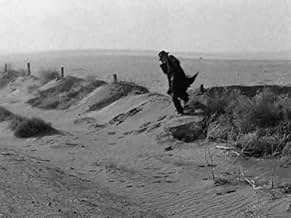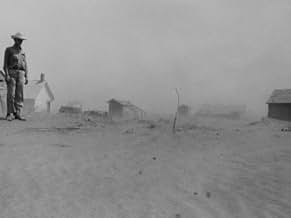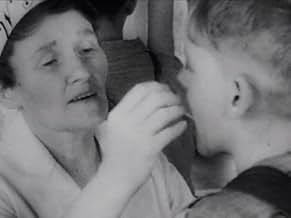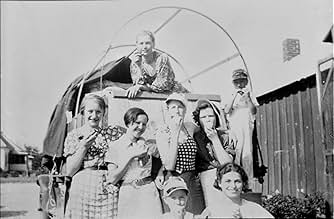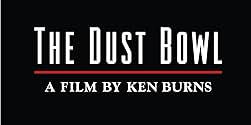VALUTAZIONE IMDb
8,2/10
2246
LA TUA VALUTAZIONE
Uno sguardo alla siccità degli anni '30 nei terreni agricoli delle praterie nordamericane e sulle sue conseguenze durante la Grande Depressione.Uno sguardo alla siccità degli anni '30 nei terreni agricoli delle praterie nordamericane e sulle sue conseguenze durante la Grande Depressione.Uno sguardo alla siccità degli anni '30 nei terreni agricoli delle praterie nordamericane e sulle sue conseguenze durante la Grande Depressione.
- Candidato a 2 Primetime Emmy
- 2 vittorie e 5 candidature totali
Sfoglia gli episodi
Recensioni in evidenza
All Americans have heard of the Dust Bowl and know it was a phenomenon associated with drought in the 1930s, and that Okies left for California, a la The Grapes of Wrath. We have also heard about the more recent droughts in the West. So the thought arises, could it happen again? But that's about it. Most non-Americans don't even know that.
With some of his documentaries on more distant subjects, Ken Burns relied on old photographs and narratives read by actors. But The Dust Bowl is the story told by the people who saw the massive dust storms, day after day, with their own eyes, breathing the dust, eating the dust, getting lost in the dust. They are often the very people in the pictures used. At at the end, we see a dedication listing the participants who had died before the documentary was released. Burns was just in time to save this bit of oral history.
What struck me initially was how objective, unemotional, and even dry was his approach, far less spirited than subjects like the Statue of Liberty, Baseball or Jazz. And the pace is leisurely, a lot of time spent looking at a lot of towering dust clouds and hearing account after account of being engulfed by dust and sand. Most film makers would have sped things up for the MTV generation, perhaps added booming sound effects and gimmicky zips and flashes to keep our attention. But this is Ken Burns, and he has the street cred to do things his way. And it was the right way. People actually lived through these dust and sand storms for years, so surely we can endure the accounts for a few hours to get a feel for it.
But this tells a larger story, of how the region was settled, telling another side of the Oklahoma land rush that I had never heard, and how government policies and World War I led to foolish overproduction of wheat on land better suited to grazing. Yes, foolish. The people involved say so, themselves, for the most part. This is not Ken Burns political propagandist, as some reviewers allege.
What struck me is how objective this account is, how balanced, presenting various sides, and grounded in fact, like good journalism. The film covers the New Deal policies of FDR to try to save the land and help those living in the Dust Bowl; it also provides insight into the origins of farm price support policies. Is this what causes some viewers to froth at the mouth? I kept waiting for the judgment, the observation that global warming could cause more dust bowls, in America, and around the world. But it never came. Perhaps he could anticipate the response. Frankly, he didn't need to spell out the connection.
With better, scientific farming practices, the Dust Bowl land could be saved, more or less. You still need rainfall, unless you are willing to drain aquifers. But the story of the Dust Bowl also offers some promise that there may be intelligent ways to adjust to the effects of climate change on agriculture. Discussion of this is the part that I wish was included.
This is a vitally important story that needs to be remembered, with lessons for our and future generations. It is also a story of the human spirit, of people who endured hardship far longer than any of us should, or probably could, bear. I am glad they got a chance to share their story with us.
-- Footnote:
A good supplementary program is The Civilian Conservation Corps episode of The American Experience, #22.1, for a larger context on the environmental and economic situation.
With some of his documentaries on more distant subjects, Ken Burns relied on old photographs and narratives read by actors. But The Dust Bowl is the story told by the people who saw the massive dust storms, day after day, with their own eyes, breathing the dust, eating the dust, getting lost in the dust. They are often the very people in the pictures used. At at the end, we see a dedication listing the participants who had died before the documentary was released. Burns was just in time to save this bit of oral history.
What struck me initially was how objective, unemotional, and even dry was his approach, far less spirited than subjects like the Statue of Liberty, Baseball or Jazz. And the pace is leisurely, a lot of time spent looking at a lot of towering dust clouds and hearing account after account of being engulfed by dust and sand. Most film makers would have sped things up for the MTV generation, perhaps added booming sound effects and gimmicky zips and flashes to keep our attention. But this is Ken Burns, and he has the street cred to do things his way. And it was the right way. People actually lived through these dust and sand storms for years, so surely we can endure the accounts for a few hours to get a feel for it.
But this tells a larger story, of how the region was settled, telling another side of the Oklahoma land rush that I had never heard, and how government policies and World War I led to foolish overproduction of wheat on land better suited to grazing. Yes, foolish. The people involved say so, themselves, for the most part. This is not Ken Burns political propagandist, as some reviewers allege.
What struck me is how objective this account is, how balanced, presenting various sides, and grounded in fact, like good journalism. The film covers the New Deal policies of FDR to try to save the land and help those living in the Dust Bowl; it also provides insight into the origins of farm price support policies. Is this what causes some viewers to froth at the mouth? I kept waiting for the judgment, the observation that global warming could cause more dust bowls, in America, and around the world. But it never came. Perhaps he could anticipate the response. Frankly, he didn't need to spell out the connection.
With better, scientific farming practices, the Dust Bowl land could be saved, more or less. You still need rainfall, unless you are willing to drain aquifers. But the story of the Dust Bowl also offers some promise that there may be intelligent ways to adjust to the effects of climate change on agriculture. Discussion of this is the part that I wish was included.
This is a vitally important story that needs to be remembered, with lessons for our and future generations. It is also a story of the human spirit, of people who endured hardship far longer than any of us should, or probably could, bear. I am glad they got a chance to share their story with us.
-- Footnote:
A good supplementary program is The Civilian Conservation Corps episode of The American Experience, #22.1, for a larger context on the environmental and economic situation.
This is a sometimes difficult-to-watch documentary about the 1930s in the western panhandle of Oklahoma and the area immediately around it, the center of what came to be called the Dust Bowl. Like Burns' other documentaries, at its center is a well-researched narrative that moves in chronological order, delivered wonderfully by his narrator, Peter Cayote, with the perfect voice for an American story.
But also like at least some of Burns' other documentaries, what makes this hit you in the gut, what makes a real impression on you, is seeing and hearing those who lived through this terrible era recall it while trying to keep their emotions in check. As one of them says late in the second part, some survived because they were strong, but others did not. You see that strength in these people. They are all in their 80s or 90s, I would guess, and some appear to be rather frail physically. But they are clearly very strong, yet very modest, individuals.
At one moment in the narrative, we are told about a photographer who was sent out by the federal government to capture the suffering of these people and their plight, so that other Americans would understand the need to help them. The photograph, a woman, was told to make sure to capture their faces and their eyes. That's what Burns does in shooting these witnesses almost 80 years later, and the power of the result is amazing.
That, of course, is the appeal of at least some of Burns' documentaries. They tell us things about America and Americans that we would like to believe are true about ourselves, at least when we are at our very best.
Did all of these witnesses lead perfect lives, with never an unkind word or thought ? Maybe, maybe not. I don't know, and I don't care. But they give us something to strive for, because they tell us that, at least in some of us, at some times, there is a remarkable resilience.
But also like at least some of Burns' other documentaries, what makes this hit you in the gut, what makes a real impression on you, is seeing and hearing those who lived through this terrible era recall it while trying to keep their emotions in check. As one of them says late in the second part, some survived because they were strong, but others did not. You see that strength in these people. They are all in their 80s or 90s, I would guess, and some appear to be rather frail physically. But they are clearly very strong, yet very modest, individuals.
At one moment in the narrative, we are told about a photographer who was sent out by the federal government to capture the suffering of these people and their plight, so that other Americans would understand the need to help them. The photograph, a woman, was told to make sure to capture their faces and their eyes. That's what Burns does in shooting these witnesses almost 80 years later, and the power of the result is amazing.
That, of course, is the appeal of at least some of Burns' documentaries. They tell us things about America and Americans that we would like to believe are true about ourselves, at least when we are at our very best.
Did all of these witnesses lead perfect lives, with never an unkind word or thought ? Maybe, maybe not. I don't know, and I don't care. But they give us something to strive for, because they tell us that, at least in some of us, at some times, there is a remarkable resilience.
10kironkid
I've only viewed part 1 (last night) and I'm anxiously awaiting part 2, which is tonight. So far, it has been very good and informative. A significant piece of American history. One we should all be knowledgeable on. We had a large part in creating this natural catastrophe, and we are doomed to do similar things if we continue to do as we are presently doing. It reminds me of the recent flooding in New York, New Jersey and Japan. Much of that damage and loss can be contributed to poor planning on mankind. Nature is cyclical. We just choose to ignore the past history.
Very good and informative. I highly recommend it.
Russ
Very good and informative. I highly recommend it.
Russ
As an immigrant I was not familiar with this episode in American history besides a few facts connected to Great Depression and migration of thousands to California so well described by John Steinbeck. This movie however showed me that it may not be only about economic woes of that era but other factors played significant role such as greed, cheating of poor farmers by unscrupulous developers in a sort of Alaskan scheme,disregard for needs of a land (notice that historians point to the fact of that area used incorrectly for wheat instead just for grazing), over extensive farming resulting in erosion and general lack of paying attention to climate. All this unfortunately reminds me of our times which makes this movie especially troubling. What saved us completely from total gloom after watching are people: beautiful farmers undefeated in the face of such calamity. I just wish that those types of Americans would be shown more often to the rest of the world and maybe they will be more liked by others. Instead what the world see are shallow celebrities, rich and arrogant businessmen. Show the world more that woman in the beaten truck with her hungry children in that famous photograph made on the way to California and she should be real American lady not Modonna or similar types. Now, on another note: what struck me about the movie is how well our heroes looked despite poverty, lack of food, dust and proper medical care. I even cracked a joke to my family that they all looked as they had just left Gap store. Compare them with contemporary society and see difference. Obesity, bulky faces, sloppy clothes, lack of grace, a hint of stupidity on our faces coming from constant looking at commercial surroundings and see how those old farmers looked dignified compared to us. They ate less but purer food, were surrounded by nature and beauty (with the exception of those 10 years of dust bowl), had deep connection to others, walked constantly... - perhaps these things made them prettier. So if there are messages coming from this movie there are following: treat nature with respect, plan for the future, save water; and in other realm: dress better, walk more and with poise and clean your house. If they could do it despite all the odds, so can we.
Oh, yes! - Man and his machines - And would you just look at what thou hast done in the name of progress and agriculture!..... Yes. Thou hast created a state-wide "dust bowl" like never imagined possible.
It sure would've been nice and convenient if man could've guiltlessly shifted the blame for this devastating disaster onto the shoulders of good, old Mother Nature (saying that she was clearly having a very bad hair day that particular decade).... But, no way, Jose. In this case, man couldn't worm his way out of this mess-of-historical-proportions that easy.
Anyways - Even though "The Dust Bowl" was definitely somewhat over-long with its 240-minute running time, it was still quite an interesting documentary that I'm sure many viewers are going to find quite intriguing to watch.
Through vintage, newsreel footage, 100s of stills, and interviews with, not only historians, but with the very people who were actually present to witness this incredible phenomenon, the viewer soon learns just how this man-made disaster of endless dust storms affected the lives of thousands of American citizens during the Depression Years of the 1930s.
Directed by Ken Burns (for PBS), and narrated by Peter Coyote, The Dust Bowl is a fascinating step back in time to an awesome occurrence that we can only hope will never have a chance, ever again, to repeat itself.
It sure would've been nice and convenient if man could've guiltlessly shifted the blame for this devastating disaster onto the shoulders of good, old Mother Nature (saying that she was clearly having a very bad hair day that particular decade).... But, no way, Jose. In this case, man couldn't worm his way out of this mess-of-historical-proportions that easy.
Anyways - Even though "The Dust Bowl" was definitely somewhat over-long with its 240-minute running time, it was still quite an interesting documentary that I'm sure many viewers are going to find quite intriguing to watch.
Through vintage, newsreel footage, 100s of stills, and interviews with, not only historians, but with the very people who were actually present to witness this incredible phenomenon, the viewer soon learns just how this man-made disaster of endless dust storms affected the lives of thousands of American citizens during the Depression Years of the 1930s.
Directed by Ken Burns (for PBS), and narrated by Peter Coyote, The Dust Bowl is a fascinating step back in time to an awesome occurrence that we can only hope will never have a chance, ever again, to repeat itself.
Lo sapevi?
- QuizExtracts from the interviews in this documentary were used by Christopher Nolan in Interstellar (2014) when depicting the dust storms on Earth.
- ConnessioniFeatured in Interstellar (2014)
- Colonne sonoreThe Plainsman
Written by John Owen Lardinois
Performed by Fiddlin' Johnny
From Cowboy Legacy
© 1997 Makoché Music
I più visti
Accedi per valutare e creare un elenco di titoli salvati per ottenere consigli personalizzati
- How many seasons does The Dust Bowl have?Powered by Alexa
Dettagli
- Data di uscita
- Paese di origine
- Sito ufficiale
- Lingua
- Celebre anche come
- Dust Bowl - Die Jahrhundertdürre
- Aziende produttrici
- Vedi altri crediti dell’azienda su IMDbPro
- Tempo di esecuzione46 minuti
- Colore
Contribuisci a questa pagina
Suggerisci una modifica o aggiungi i contenuti mancanti

Divario superiore
By what name was The Dust Bowl (2012) officially released in India in English?
Rispondi
